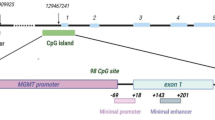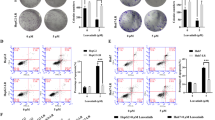Abstract
Multidrug resistance (MDR) is a significant problem underlying the poor prognosis associated with gliomas. Hypoxia-inducible factor-1α (HIF-1α) is thought to induce the genes expression involved in MDR. To evaluate the effect of silencing HIF-1α in human glioma T98G cells, cells were transfected with HIF-1α-small interference RNA (HIF-1α-siRNA) and cultured under hypoxic conditions. The effect of HIF-1α-siRNA on HIF-1α and multidrug resistance-associated protein 1 gene (MRP1) and protein levels was determined. Silencing rates of HIF-1α were 90%, 85%, and 88% at 24, 48, 72 h post-transfection, respectively. Corresponding rates of HIF-1α protein were 74.5%, 61.1% and 59.1%. MRP1 protein levels decreased by 7.6%, 36.8% and 45.2%. HIF-1α-siRNA transfected cells were significantly more sensitive to doxorubicin and etoposide compared to non-transfected cells. These findings suggest that the HIF-1α plays a role in mediating chemotherapeutic drug resistance in glioma cells. HIF-1α silencing may prove to be an effective therapeutic means of treating gliomas.



Similar content being viewed by others
References
Yamanaka R (2008) Cell- and peptide-based immunotherapeutic approaches for glioma. Trends Mol Med 14:228–235
National Comprehensive Cancer Network Clinical Practice Guidelines in Oncology (2008) Central Nervous System Cancers V.1
DeAngelis LM (2001) Brain tumors. N Engl J Med 344:114–123
Davis FG, Kupelian V, Freels S et al (2001) Prevalence estimates for primary brain tumors in the United States by behavior and major histology groups. NeuroOncol 3:152–158
Curran WJ Jr, Scott CB, Horton J et al (1993) Recursive partitioning analysis of prognostic factors in three radiation therapy oncology group malignant glioma trials. J Natl Cancer Inst 85:704–710
Song X, Liu X, Chi W et al (2006) Hypoxia-induced resistance to cisplatin and doxorubicin in non-small cell lung cancer is inhibited by silencing of HIF-1alpha gene. Cancer Chemother Pharmacol 58:776–784
Comerford KM, Wallace TJ, Karhausen J et al (2002) Hypoxia-inducible factor-1- dependent regulation of the multidrug resistance (MDR1) gene. Cancer Res 62:3387–3394
Goldman B (2003) Multidrug resistance: can new drugs help chemotherapy score against cancer? J Natl Cancer Inst 95:255–257
Mattern J (2003) Drug resistance in cancer: a multifactorial problem. Anticancer Res 23:1769–1772
Fardel O, Lecureur V, Guillouzo A (1996) The P-glycoprotein multidrug transporter. Gen Pharmacol 27:1283–1291
Cole SP, Bhardwaj G, Gerlach JH et al (1992) Overexpression of a transporter gene in a multidrug-resistant human lung cancer cell line. Science 258:1650–1654
Decleves X, Fajac A, Lehmann-Che J et al (2002) Molecular and functional MDR1-Pgp and MRPs expression in human glioblastoma multiforme cell lines. Int J Cancer 98:173–180
Mohri M, Nitta H, Yamashita J (2000) Expression of multidrug resistance- associated protein (MRP) in human gliomas. J Neurooncol 49:105–115
Zhu H, Chen XP, Luo SF et al (2005) Involvement of hypoxia-inducible factor-1-alpha in multidrug resistance induced by hypoxia in HepG2 cells. J Exp Clin Cancer Res 24:565–574
Kizaka-Kondoh S, Inoue M, Harada H et al (2003) Tumor hypoxia: a target for selective cancer therapy. Cancer Sci 94:1021–1028
Han HK, Han CY, Cheon EP et al (2007) Role of hypoxia-inducible factor-alpha in hepatitis-B-virus X protein-mediated MDR1 activation. Biochem Biophys Res Commun 357:567–573
Vezmar M, Georges E (2000) Reversal of MRP-mediated doxorubicin resistance with quinoline-based drugs. Biochem Pharmacol 59:1245–1252
Livak KJ, Schmittgen TD (2001) Analysis of relative gene expression data using real-time quantitative PCR and the 2(-delta delta C(T)) method. Methods 25:402–408
Yu JY, DeRuiter SL, Turner DL (2002) RNA interference by expression of short- interfering RNAs and hairpin RNAs in mammalian cells. Proc Natl Acad Sci USA 99:6047–6052
Brummelkamp TR, Bernards R, Agami R (2002) A system for stable expression of short interfering RNAs in mammalian cells. Science 296:550–553
Lee NS, Dohjima T, Bauer G et al (2002) Expression of small interfering RNAs targeted against HIV-1 rev transcripts in human cells. Nat Biotechnol 20:500–505
Miyagishi M, Taira K (2002) U6 promoter-driven siRNAs with four uridine 3′ overhangs efficiently suppress targeted gene expression in mammalian cells. Nat Biotechnol 20:497–500
Elbashir SM, Harborth J, Lendeckel W, Yalcin A, Weber K, Tuschl T (2001) Duplexes of 21-nucleotide RNAs mediate RNA interference in cultured mammalian cells. Nature 411:494–498
Acknowledgments
This study was supported by the Country Natural Science Fund and West China Hospital.
Author information
Authors and Affiliations
Corresponding author
Rights and permissions
About this article
Cite this article
Chen, L., Feng, P., Li, S. et al. Effect of Hypoxia-inducible Factor-1α Silencing on the Sensitivity of Human Brain Glioma Cells to Doxorubicin and Etoposide. Neurochem Res 34, 984–990 (2009). https://doi.org/10.1007/s11064-008-9864-9
Received:
Accepted:
Published:
Issue Date:
DOI: https://doi.org/10.1007/s11064-008-9864-9




